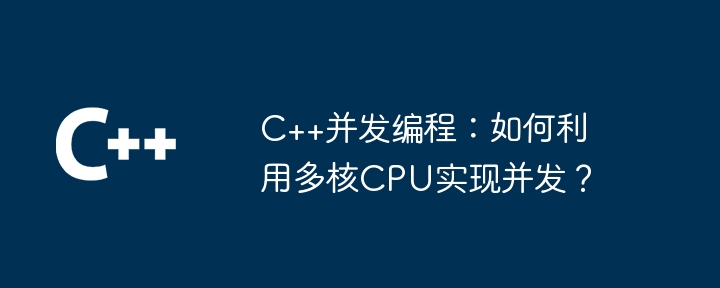C++並發程式設計:如何利用多核心CPU實作並發?
C 並發程式設計透過建立執行緒、互斥鎖和條件變數來充分利用多核心 CPU 的優勢。創建線程允許任務並行執行。互斥鎖充當鎖,確保共享資料不會被多個執行緒同時訪問,從而避免資料損壞。條件變數用於通知執行緒特定條件已滿足,並與互斥鎖配合使用以防止執行緒繼續執行直到條件滿足。

C 並發程式設計:解鎖多核心CPU
前言
現代CPU 通常具有多個核心,透過充分利用這些核心,我們可以在並行執行任務時顯著提高程式碼效率。 C 提供了各種並發程式設計工具,讓程式設計師能夠輕鬆建立可以同時執行多個任務的應用程式。
建立執行緒
建立執行緒是表示並發的基本建構塊。在 C 中,可以使用 std::thread 類別建立新執行緒。它接受一個可調用物件作為參數,該物件指定在單獨的執行緒中執行的任務。
#include <iostream>
#include <thread>
void hello_world() {
std::cout << "Hello, world!" << std::endl;
}
int main() {
std::thread thread1(hello_world);
thread1.join();
return 0;
}在上面的程式碼中,hello_world() 函數是可呼叫對象,它只需向控制台列印一條訊息。 std::thread 建構子建立一個新執行緒並執行可呼叫物件。 thread1.join() 阻塞主線程,直到新線程完成。
互斥鎖
當執行緒並發存取共享資料時,互斥鎖非常重要。它們充當鎖,防止多個執行緒同時存取關鍵部分,從而避免資料損壞。在 C 中,可以使用 std::mutex 類別建立互斥鎖。
#include <iostream>
#include <thread>
#include <mutex>
std::mutex m; // 全局互斥锁
void increment(int& counter) {
std::lock_guard<std::mutex> lock(m); // 获取互斥锁
++counter;
}
int main() {
int counter = 0;
std::thread thread1(increment, std::ref(counter));
std::thread thread2(increment, std::ref(counter));
thread1.join();
thread2.join();
std::cout << "Final counter value: " << counter << std::endl;
return 0;
}在這個範例中,increment() 函數對共享變數 counter 進行遞增。我們使用 std::lock_guard 來取得互斥鎖,確保只有一個執行緒可以同時執行關鍵部分。這種機制確保兩個執行緒不會同時遞增 counter,從而避免資料競爭。
條件變數
條件變數用於通知執行緒特定條件已滿足。它們與互斥鎖一起使用,以確保執行緒在滿足條件之前不會繼續執行。在 C 中,可以使用 std::condition_variable 類別建立條件變數。
#include <iostream>
#include <thread>
#include <condition_variable>
#include <mutex>
std::mutex m; // 全局互斥锁
std::condition_variable cv; // 全局条件变量
bool ready = false; // 共享布尔标志
void producer() {
std::lock_guard<std::mutex> lock(m); // 获取互斥锁
ready = true; // 设置共享标志为 true
cv.notify_one(); // 通知一个等待的线程
}
void consumer() {
std::unique_lock<std::mutex> lock(m); // 获取互斥锁(并锁定它)
while (!ready) // 等待共享标志为 true
cv.wait(lock); // 释放互斥锁并等待
}
int main() {
std::thread producer_thread(producer);
std::thread consumer_thread(consumer);
producer_thread.join();
consumer_thread.join();
return 0;
}在此範例中,我們使用條件變數來協調生產者和消費者執行緒之間的交互作用。 producer() 函數設定共享標誌 ready 為 true 並通知消費者執行緒。 consumer() 函數透過等待條件變數來等待共用標誌為 true,然後繼續執行。
以上是C++並發程式設計:如何利用多核心CPU實作並發?的詳細內容。更多資訊請關注PHP中文網其他相關文章!

熱AI工具

Undresser.AI Undress
人工智慧驅動的應用程序,用於創建逼真的裸體照片

AI Clothes Remover
用於從照片中去除衣服的線上人工智慧工具。

Undress AI Tool
免費脫衣圖片

Clothoff.io
AI脫衣器

Video Face Swap
使用我們完全免費的人工智慧換臉工具,輕鬆在任何影片中換臉!

熱門文章

熱工具

記事本++7.3.1
好用且免費的程式碼編輯器

SublimeText3漢化版
中文版,非常好用

禪工作室 13.0.1
強大的PHP整合開發環境

Dreamweaver CS6
視覺化網頁開發工具

SublimeText3 Mac版
神級程式碼編輯軟體(SublimeText3)
 C#與C:歷史,進化和未來前景
Apr 19, 2025 am 12:07 AM
C#與C:歷史,進化和未來前景
Apr 19, 2025 am 12:07 AM
C#和C 的歷史與演變各有特色,未來前景也不同。 1.C 由BjarneStroustrup在1983年發明,旨在將面向對象編程引入C語言,其演變歷程包括多次標準化,如C 11引入auto關鍵字和lambda表達式,C 20引入概念和協程,未來將專注於性能和系統級編程。 2.C#由微軟在2000年發布,結合C 和Java的優點,其演變注重簡潔性和生產力,如C#2.0引入泛型,C#5.0引入異步編程,未來將專注於開發者的生產力和雲計算。
 vscode在哪寫代碼
Apr 15, 2025 pm 09:54 PM
vscode在哪寫代碼
Apr 15, 2025 pm 09:54 PM
在 Visual Studio Code(VSCode)中編寫代碼簡單易行,只需安裝 VSCode、創建項目、選擇語言、創建文件、編寫代碼、保存並運行即可。 VSCode 的優點包括跨平台、免費開源、強大功能、擴展豐富,以及輕量快速。
 Golang和C:並發與原始速度
Apr 21, 2025 am 12:16 AM
Golang和C:並發與原始速度
Apr 21, 2025 am 12:16 AM
Golang在並發性上優於C ,而C 在原始速度上優於Golang。 1)Golang通過goroutine和channel實現高效並發,適合處理大量並發任務。 2)C 通過編譯器優化和標準庫,提供接近硬件的高性能,適合需要極致優化的應用。
 Golang vs.C:性能和速度比較
Apr 21, 2025 am 12:13 AM
Golang vs.C:性能和速度比較
Apr 21, 2025 am 12:13 AM
Golang適合快速開發和並發場景,C 適用於需要極致性能和低級控制的場景。 1)Golang通過垃圾回收和並發機制提升性能,適合高並發Web服務開發。 2)C 通過手動內存管理和編譯器優化達到極致性能,適用於嵌入式系統開發。
 Python與C:學習曲線和易用性
Apr 19, 2025 am 12:20 AM
Python與C:學習曲線和易用性
Apr 19, 2025 am 12:20 AM
Python更易學且易用,C 則更強大但複雜。 1.Python語法簡潔,適合初學者,動態類型和自動內存管理使其易用,但可能導致運行時錯誤。 2.C 提供低級控制和高級特性,適合高性能應用,但學習門檻高,需手動管理內存和類型安全。
 Golang和C:性能的權衡
Apr 17, 2025 am 12:18 AM
Golang和C:性能的權衡
Apr 17, 2025 am 12:18 AM
Golang和C 在性能上的差異主要體現在內存管理、編譯優化和運行時效率等方面。 1)Golang的垃圾回收機制方便但可能影響性能,2)C 的手動內存管理和編譯器優化在遞歸計算中表現更為高效。
 表演競賽:Golang vs.C
Apr 16, 2025 am 12:07 AM
表演競賽:Golang vs.C
Apr 16, 2025 am 12:07 AM
Golang和C 在性能競賽中的表現各有優勢:1)Golang適合高並發和快速開發,2)C 提供更高性能和細粒度控制。選擇應基於項目需求和團隊技術棧。
 vscode如何執行代碼
Apr 15, 2025 pm 09:51 PM
vscode如何執行代碼
Apr 15, 2025 pm 09:51 PM
在 VS Code 中執行代碼只需六個步驟:1. 打開項目;2. 創建和編寫代碼文件;3. 打開終端;4. 導航到項目目錄;5. 使用適當的命令執行代碼;6. 查看輸出。






